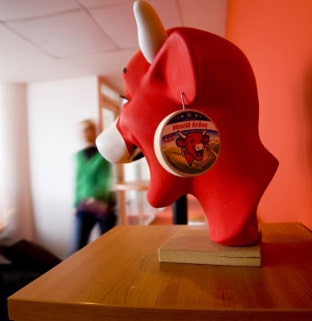Bel Group’s Worldwide Transformation
For Bel Group the future will look a lot like the past.
“We believe that plant-based foods are the future of the products we’ll make,” says Florian Sauvin, Bel Group’s chief transformation officer since May 2019.
That is a bold statement for a company that has been making cheese for over 150 years. The France-based organization, formerly known as Fromageries Bel, sells cheeses under iconic brands such as Babybel and Laughing Cow. Yet Bel’s leadership recognizes the growing interest in organic and sustainable foods, along with the rising popularity of plant-based diets. In 2016, for instance, Bel acquired the MOM Group, which makes natural fruit snacks like GoGo SqueeZ that tout healthy and organic ingredients.
But Bel is not interested in merely following trends; it wants to lead them. That is why, in 2015, it set an ambitious goal of doubling its annual sales to €5 billion by 2025. A couple of years into that timeline, however, the organization was not on target to meet its objective. In fact, its bottom line had fallen as the cost of materials continued to rise.
“Just setting an objective was not going to do it,” says Mr. Sauvin, whose family has owned Bel since its start in 1865. To adapt to new and changing market demands, Bel’s organizational structure itself had to change. Share on X “We needed a plan, and we needed the right organization to make it happen,” he explains.
“Just setting an objective was not going to do it. We needed a plan, and we needed the right organization to make it happen.”
—Florian Sauvin, chief transformation officer, Bel Group
Unifying Vision
In the past, Bel Group had been organized geographically in about half a dozen zones, including Europe and the United States. Each had its own operational infrastructure, and therefore its own vice president and finance, human resources (HR), marketing and sales departments.
“They behaved very much like silos,” Mr. Sauvin says. “There was little communication between the zones, or between the zones and corporate headquarters.”
If Bel was going to hit its ambitious sales goal, it had to work as one entity, with various brands and regions clearly aligned in service to the larger organization. But this would be easier said than done for an organization positioned in different markets on different continents, with dozens of brands each with its own technical and logistical requirements.
So, in 2018, Bel moved to adopt a different organizational structure—one that would prioritize its brands first and its geographies second. To do this, Bel created new general manager (GM) roles for each of its five core brands and each of its 12 new geographic “clusters” (the company’s name for a group of neighboring countries). The move would centralize most support functions, such as finance and HR, at Bel headquarters.

The change in structure required that each brand GM assume responsibility for that subsidiary’s global performance. Furthermore, each cluster GM would serve as the intermediary and communicator between headquarters and the subsidiaries.
“So when we talk to all of our countries, we can address just 12 people and know that the message will be spread to them,” Mr. Sauvin says.
With a new organizational structure in place, Bel was finally poised to realize its future. But breaking through would require just as bold a shift in the company’s culture. And with the official launch of the reorganization slated for April 2019, Mr. Sauvin and his fellow leaders knew they had to act fast.
Mr. Sauvin and the executive team recognized that not every potential problem could be foreseen, much less resolved, on such a short timeline. So they determined five core areas for senior leaders to address, asking them to identify the best ways to work to suit the new organizational structure. Those core areas were: the budgeting process, the innovation process, sales and operations planning, the relationship between brand GMs and cluster GMs, and how individual factory directors would relate to directors overseeing groups of factories.
“Once we agreed on the ways of working for these five core areas, all the rest would follow,” Mr. Sauvin says.
With focus areas now in place, all 50 leaders hashed out Bel’s new ways of working and compiled them all in a book. For instance, having abolished the siloed zone system, the brand GMs now had authority over each brand’s global marketing budget. “But we had to define the rules for that budget and who decides how to spend it,” Mr. Sauvin explains. So leaders crafted rules that, for example, would help brand GMs determine the right amount to spend on marketing to increase sales without cutting into the profit margin.
By design, the book detailing the new approach was a rough draft rather than a finished manuscript, says Mr. Sauvin. “We didn’t have time to argue forever about this book,” he explains. “We wrote the rules by the end of March, and they were not perfect. But I said, ‘That’s done; I don’t want to hear about any other changes.’”
Instead, Mr. Sauvin and his team instructed Bel’s business leaders to implement the new ways of working over several months and then reconvene in September 2019 to assess what did and did not work well. Only then would he and his team consider further changes.
There were two reasons behind that decision, he says. First, the business leaders could not predict how any of their individual changes might impact the rest of the organization. And second, Mr. Sauvin and his team did not want leaders to abandon the changes because they felt unfamiliar. Instead, they wanted them to base any proposed revisions on data and facts, not reactions.
“If we change the new ways of working, we want to change them for good reasons, not because someone doesn’t feel comfortable with them,” he says.
Almost none of the managers involved in the book would question the intent of designing new ways of working from a brand-centric perspective, says Insigniam partner Guillaume Pajeot. “It made perfect sense but raised questions that went against years of practices and habits. The jump was so high that for some it felt like going to work for a new company when the new ways of working were enforced.”
“If we change the new ways of working, we want to change them for good reasons, not because someone doesn’t feel comfortable with them.”
—Florian Sauvin
Beyond Perfectionism
Getting out of their comfort zone would be an essential component of moving the organization into the future. Bel’s new governance model would stress something called a “dream week,” where, for one week each month, all five brand GMs would convene to review their respective brand’s performance and make decisions about its most pressing issues. Each meeting could not take more than a couple of hours and had to focus on no more than three priorities.
“We want each brand to focus on the limited number of things it will deliver—not 50 things they want to work on,” Mr. Sauvin explains.
Brand GMs at first objected, stating that two hours was not enough time to review everything. Exactly, Mr. Sauvin countered. “Culturally at Bel, we’re an organization that wants to do everything perfectly, so it’s very hard for this organization to focus on just three issues now and to address the others later,” he says. “If we try to deliver 50 things, none of them get delivered.”

Changing that culture of myopic perfectionism will help Bel become much more agile—a necessity if the company is to successfully tackle the challenges of the future, says Mr. Sauvin. In the past, he notes, Bel sometimes took seven years to take a new product from idea to market. “We tested and retested everything.” And yes, he adds, some testing areas, like quality control, cannot be compromised. But other areas, like packaging design, should not get stuck in paralysis by analysis.
“In a culture of consensus and very high expectations on thoroughness, this was a U-turn to many who have been used to making careful business choices,” Mr. Pajeot says. “Speeding the business-decision-making pace was a way to break the rhythm of new product launches that had become a hurdle to accelerate the growth of the group.” Share on X
Mr. Sauvin recalls how marketers would present Bel with “a pile of studies” showing how great a product idea seemed. “The only real test that makes sense is sales—people taking money out of their pockets to pay for products—not having a focus group tell us a product is great,” Mr. Sauvin explains. He wants the new Bel to invest less time preparing a product for release and more time gauging the market’s initial interest in the product before fine-tuning it on the fly.
Mr. Sauvin knows that such a fundamental change in philosophy can be unsettling for a well-established organization with entrenched methods. To warm employees to this new philosophy, he delivered a companywide guarantee: If these new quick-to-market products fail, employees will not face professional repercussions, such as losing a bonus.
“We make that guarantee to the people who put an unfinished product on the shelf even if the product is a failure, as long as we learn from it,” he says.
New Decision Rights—and New Results
But it was not only employees who would have to learn Bel’s new philosophy. New ways of working had to remake the C-suite as well. For its part, the company’s executive committee understood that it would have to change its traditional pyramid decision-making structure, where most of the power rested at the top.
“The culture of the organization used to be that whenever there was something complicated, the executive committee had to put a stamp on it.”
—Florian Sauvin
“The culture of the organization used to be that whenever there was something complicated, the executive committee had to put a stamp on it,” Mr. Sauvin says. As part of the transformation, the C-suite defined the kinds of decisions it would and would not make—now delegating all budgetary decisions, for example, to the CFO and two other executive team members instead of the entire committee.
But change does not happen overnight. “This delegation of decision-making power from the C-suite down to senior management looks great on paper and will need to be supported, if not piloted,” Mr. Pajeot says. “Culture transformation takes time, and the C-suite might become impatient and intervene in domains they have delegated to accelerate the process. This is one of the key roles of the CTO—to help the C-suite to maintain the right balance there.”
From the barn to the boardroom, Bel’s new far-reaching changes are already producing marked results. For one thing, last year Bel saved tens of millions of euros in potentially wasted costs and inefficiencies.
The success has been sweet. Mr. Sauvin points to a seminal moment, just a couple of weeks after the April launch, when he knew that the reorganization would take hold. Brand GMs delivered presentations on the challenges their brands faced and the innovations they intended to pursue. The presentation from Laughing Cow’s GM stood out.
“Was the plan perfect? No. Did it take everything into account? No. But was it bold? Yes. Did it show enthusiasm? Yes. And did it show cohesion between that brand GM and other managers? Yes,” Mr. Sauvin says. “For me, that was a sign that this new organization had started to work.”
This article appeared in the Winter 2020 issue of Insigniam Quarterly, with the headline “Bold Change for a Bold Goal.” To begin receiving IQ, go here.



